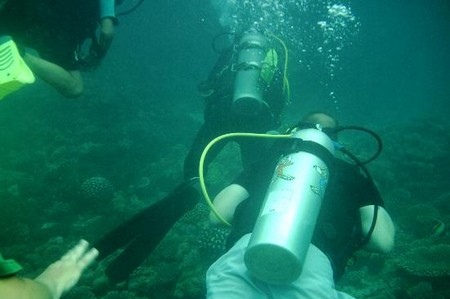The Indian Ocean is a vast tropical body of water that stretches from the coast of East Africa to the coast of Western Australia and is bordered by India and Indonesia in the north. It includes within it the islands of the Seychelles and Mauritius, the Laccadive Islands, Sri Lanka and the Maldives. All locations offer spectacular diving, but none is more popular than the Maldives.
The Maldives
The islands of the Maldives are coralline, growing on the rims of sunken, prehistoric volcanoes, or atolls. ‘Atoll’ is a Divehi (the language spoken on the islands) word that has been adopted into the English language to describe the way the islands are ranged around a lagoon of calmer water. In Divehi, ‘atoll’ actually means ‘administrative district’. Each island is only a few inches above sea level, covered in coconut palms and surrounded by turquoise sea.
Until the recent development of sophisticated tourism and hotel island resorts that rival the best of the Caribbean, the only industries of the Maldives were tuna fishing and scuba diving. Consequently, every holiday island is well equipped with an up-to-date diving centre, and there is now a large choice of live-aboard dive boats, too.
All the atolls have world-class diving to offer, but Ari Atoll, South Male Atoll and North Male Atoll have the best. Strong currents force their way through the gaps between the islands according to the season and this brings both clear water and plenty of nutrients to feed the marine animals.
Maldives marine life Huge schools of blue-lined snapper mark every reef in the Maldives. The giant Napoleon wrasses are almost tame because they encounter divers so often. Exotically striped oriental sweetlips are just one species of several types of sweetlips to be seen. Manta rays glide between the reefs, feeding on the plankton. These gentle giants come into favourite reefs to allow smaller fishes to clean parasites from their skin and gills, which the cleaners do in return for a free meal. The manta rays are very well organised creatures, forming an orderly queue to wait for attention. Up to 40 animals have been seen waiting their turn.
The feeding of sharks by divers to encourage their appearance has now been banned in the Maldives. However, shark fishing has also been banned to some extent, and the shark population is making a comeback after many years of depletion by Chinese fishing fleets.
Ecological disaster
In 1998, the extensive coral reefs of the Maldives were almost destroyed by coral bleaching that is thought to have been caused by a sudden rise in water temperature. It has taken eight years for some of the reefs to recover, but with or without the coral, the channels between the reefs still offer superb, world-class diving thanks to the oceanic animals that are attracted to the currents.
The best time to go to the Maldives for diving is during the dry season, which is from December to June. The currents are at their strongest in January.
